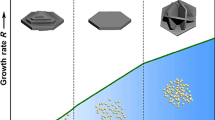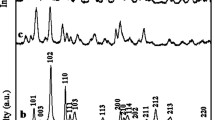Abstract
Design and synthesis of super-nanostructures have obtained increasing attention in nanotechnology. A series of superstructured-nanonetwork and nested-nanonetwork bismuth compounds have been developed recently based on lattice-directed topotactic transformation. Here we further develop some specific superstructures by transformation within different crystalline types, such as hexagonal BiI3 micro/nanoplates, tetragonal BiOI micro/nanoplates and nested two-dimensional (2D) orthogonal Bi2S3 nanonetworks, based on the lattice matching between the product and precursor. The method offers a convenient and common route in synthesizing heterojunctions and bi-material nanostructures similarly.




Similar content being viewed by others
References
Duan X, Niu C, Sahi V et al (2003) High-performance thin-film transistors using semiconductor nanowires and nanoribbons. Nature 425:274–278
Guo CF, Wang Y, Jiang P et al (2008) Zinc oxide nanostructures: epitaxially growing from hexagonal zinc nanostructures. Nanotechnology 19:445710
Huang MH, Wu Y, Feick H et al (2001) Catalytic growth of zinc oxide nanowires by vapor transport. Adv Mater 13:113–116
Bhana S, Rai BK, Mishra SR et al (2012) Synthesis and properties of near infrared-absorbing magnetic–optical nanopins. Nanoscale 4:4939–4942
Xu CX, Sun XW (2003) Field emission from zinc oxide nanopins. Appl Phys Lett 83:3806–3808
Lao JY, Huang JY, Wang DZ et al (2003) ZnO nanobridges and nanonails. Nano Lett 3:235–238
Cai J, Ruffieux P, Jaafar R et al (2010) Atomically precise bottom-up fabrication of graphene nanoribbons. Nature 466:470–473
Xia Y, Yang P, Sun Y et al (2003) One-dimensional nanostructures: synthesis, characterization and applications. Adv Mater 15:353–389
Pan ZW, Wang ZL (2001) Nanobelts of semiconducting oxides. Science 291:1947–1949
Wang Y, Miao J, Tian Y et al (2011) TiO2 micro-devices fabricated by laser direct writing. Opt Express 19:17390–17395
Cho KS, Talapin DV, Gaschler W et al (2005) Designing PbSe nanowires and nanorings through oriented attachment of nanoparticles. J Am Chem Soc 127:7140–7147
Kong XY, Ding Y, Yang R et al (2004) Single-crystal nanorings formed by epitaxial self-coiling of polar nanobelts. Science 303:1348–1351
He JH, Yang RS, Chueh YL et al (2006) Aligned AlN nanorods with multi-tipped surfaces-growth, field-emission, and cathodoluminescence properties. Adv Mater 18:650–654
Wu JJ, Liu SC (2002) Low-temperature growth of well-aligned ZnO nanorods by chemical vapor deposition. Adv Mater 14:215
Liu C, Li F, Ma LP et al (2010) Advanced materials for energy storage. Adv Mater 22:E28–E62
Liu N, Tang ML, Hentschel M et al (2010) Nanoantenna-enhanced gas sensing in a single tailored nanofocus. Nat Mater 10:631–636
Xin S, Guo YG, Wan LJ (2012) Nanocarbon networks for advanced rechargeable lithium batteries. Acc Chem Res 45:1759–1769
Li L, Sun N, Huang Y et al (2008) Topotactic transformation of single-crystalline Precursor discs into disc-like Bi2S3 nanorod networks. Adv Funct Mater 18:1194–1201
Guo CF, Cao S, Zhang J et al (2011) Topotactic transformations of superstructures: from thin films to two-dimensional networks to nested two-dimensional networks. J Am Chem Soc 133:8211–8215
Guo CF, Zhang J, Tian Y et al (2012) A general strategy to superstructured networks and nested self-similar networks of bismuth compounds. ACS Nano 6:8746–8752
Guo CF, Zhang J, Wang M et al (2013) A strategy to prepare wafer scale bismuth compound superstructures. Small 9:2394–2398
Reddy KH, Martha S, Parida KM (2013) Fabrication of novel p-BiOI/n-ZnTiO3 heterojunction for degradation of rhodamine 6G under visible light irradiation. Inorg Chem 52:6390–6401
Cao J, Xu B, Lin H et al (2012) Novel heterostructured Bi2S3/BiOI photocatalyst: facile preparation, characterization and visible light photocatalytic performance. Dalton Trans 41:11482–11490
Acknowledgments
This work was supported by the National Natural Science Foundation of China (61006078, 11374069), the National Basic Research Program of China (2010CB934102), and the Chinese Academy of Sciences Strategic Pilot Program (XDA09020300).
Author information
Authors and Affiliations
Corresponding author
Additional information
SPECIAL TOPIC: Nano Materials
About this article
Cite this article
Zhang, J., Guo, C., Tian, Y. et al. Superstructure transformations from hexagonal to tetragonal microplates and nested two-dimensional nanonetworks. Chin. Sci. Bull. 59, 1787–1793 (2014). https://doi.org/10.1007/s11434-014-0292-8
Received:
Accepted:
Published:
Issue Date:
DOI: https://doi.org/10.1007/s11434-014-0292-8




